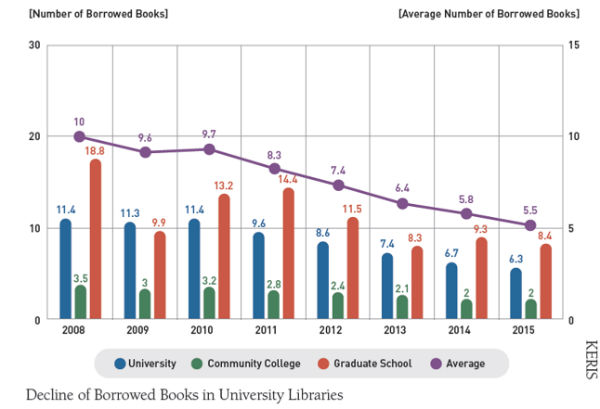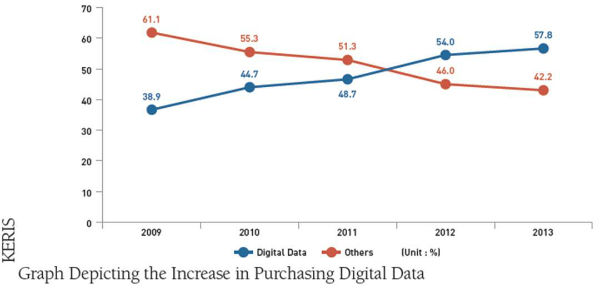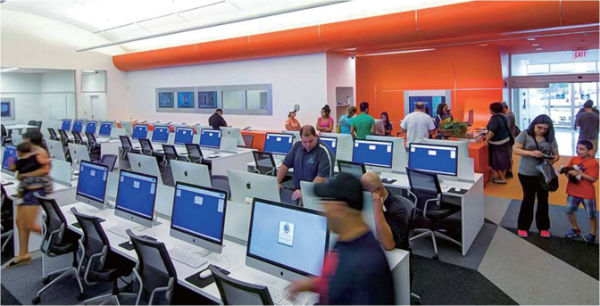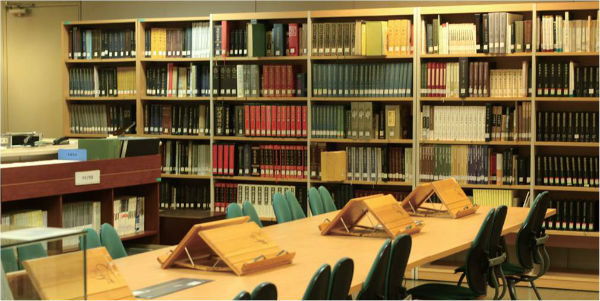How often do you borrow books from the university library? What comes to your mind when you hear the term “university library?” For some students, it is merely just a place to borrow books to study or take a rest when there is no class. However, in modern days, the university library is not only a place to store books, but also to manage all kinds of data, such as e-books and DVDs. The Sungkyun Times (SKT) investigates the modern roles and responsibilities of university libraries, which are still an important institution for university students. In addition, the SKT interviewed a librarian of Jongyeonggak in Sungkyunkwan Universty (SKKU), the first university library in Korea, with the expectation of increased warm attention towards the library.
University Library in Korea
A university library is a library affiliated with the institution of higher education, the university. According to the National Statistical Office, there are 670 university libraries in Korea. In SKKU, there are several university libraries including the Central Library in the Humanities and Social Sciences Campus and Samsung Library in the Natural Sciences Campus. As the term suggests, a university library serves only members of the university, unlike normal libraries. Therefore, a university library has the role of focusing on information specifically for university students and faculties.
The Change on University Library
Internet, the Turning Point
Internet has changed the distribution structure of information in society. The stationary space of offering and receiving information is no longer necessary. As the Internet enabled people to search for any kind of information anywhere at any time, there is no longer any need university students to visit university libraries as often as they did in the past. Before the Internet was developed, the library was almost the only place to acquire information, but now search engines such as Google and Naver can direct users to any information that they seek. In the past, a “book” was also the only source of information. Nowadays, however, books are no longer compulsory, even in classrooms. Students prefer Googling by entering keywords over looking through paper dictionaries.
Decrease of Borrowing Books in University Library
As a result of the use of Internet, the number of library users has decreased. The statistics prove the decrease of its users and depicts the crisis of the modern university library. According to Korea Education & Research Information Service (KERIS), the number of books borrowed by university students has been decreasing throughout the years. KERIS announced that the average number of borrowed books per enrolled university student in 2008 was ten, but dropped to 5.5 in 2015. The continuous decrease in this number shows that the libraries need to admit the changing behaviorisms of information searching and usage of libraries.

Importance of Digital Data
The statistics in the previous paragraph do not indicate that the library is no longer needed, but imply the need for changes in library services. Several decreases of the rate in borrowed books could have been caused by the preference of using the Internet library services provided by the university library over visiting the physical library to borrow books. Another graph shows that within the past six years, the percentage of buying digital data has been increased. In other words, the increased use of digital data might have replaced the need to borrow books from libraries. This phenomenon shows that university libraries should pay attention to digital services and try to use this trend as another new paradigm of renovation.

University Library Overcomes the Crisis
Struggles of the University Library
It is true that modern university libraries are having difficulties due to the emergence of the Internet, but some university libraries are wisely overcoming and solving these problems. For example, some university libraries are taking into consideration the trend and the flow of society to present data and management of space into desired direction of the library users. University libraries are struggling to keep their users by enacting several changes.
First, the university library is extending its role. In the past, university libraries had focused on printed materials that are stationary and organized in bookshelves. Now, however, they are managing invisible data such as digitalized theses purchased from publishers. The space of the university library is also being utilized in many different ways. University libraries are arranging spaces for students and professors to carry out team projects or study inside the library. For instance, in SKKU, there are spare rooms such as “Creative Zone” and “Team Project Room” for students to freely use. In addition, SKKU libraries provide multimedia data involving DVD and computers that have statistic analyzing programs. Many culture activities are emerging in the university library to encourage the active use of the library. For example, SKKU provides students with programs such as book-picnics and book-reading classes with professors. As the university library is expanding its roles, the name of the library itself is also changing. In 2004, SKKU’s libraries had changed the Korean names from “Do-seo-gwan” (Library) to “Hak-sul-jung-bo-kwan” (Research and Information Center). The term in English, however, is still remains coined as “library.”
Future Prospects of University Library
Digital Curation
Digital curation is defined by the University of Illinois as “the active and on-going management of data.” It enables data discovery and retrieval, maintaining the quality of the data. Data curation is crucial for any informative centers. As the world is developing rapidly, there should be preparation against hacking, which causes the dangers of data loss. Many researchers point out that university libraries in Korea are not managing the curation well, which must be solved in the near future for data safety.
Bookless Library
Many university libraries around the world are struggling from a lack of space in libraries. As the amount of books is accumulating in the libraries, the usage of the space is ineffcient. As a result, many American universities are moving the books out of the library and instead, putting out digital mechanisms for searching digital data or making study rooms. In 2010, the University of Texas opened a bookless library, and now, many universities including Harvard and Duke are following the trend. Bookless libraries can be easily imagined as they are similar to SKKU’s “Kingo Zone,” which has PCs and multimedia services. The difference is that bookless libraries are 100% full of digital mechanisms, without any books.

Jongyeonggak, Korea’s First University Library
Jongyeonggak is Korea’s first university library, established during the Joseon Dynasty inside Sungkyunkwan in March 1475. King Seongjong, the ninth King of the Joseon Dynasty, was intensely involved in educational affairs and ordered the construction of Jongyeonggak for Confucian students. At the time, the students were having difficulty in their studies due to the scarcity of books and documents. Jongyeong means “keeping the documents with respect.” As the library had a role of storing books and documents for Confucian students, it was regarded as an important institute on a national scale. In accordance to its enormous importance, the SKT interviewed the librarian of Jongyeonggak to attain a deeper understanding of libraries in modern times.
Interview
Interviewee: Yong Joon Choi
Librarian at Jongyeonggak , Academy of East Asian Studies
Nice meeting you, Mr. Choi. Can you introduce Jongyeonggak to Kingos?
Hello, nice meeting you too. Jongyeonggak is the first university library in Korea, located in Sungkyunkwan. It was built in the Joseon Dynasty, but unfortunately caught on fire several times due to wars and invasions. The fire burned a majority of the books in the library and now the building no longer stores books. In 2000, the university planned a project to make an institute of Eastern studies, and was named Jongyeonggak . The institute is located on the fourth floor of the 600th Anniversary Hall. The purpose of naming the institute after Jongyeonggak was to revive the original passion of the library and to turn it into an effective research center to offer useful information to the users.
What are the special values that Jongyeonggak holds?
As I mentioned before, it is the first university library established in Korea. Also, the current institute has many networks with various university libraries all across Asia by signing contracts. These contracts enable the active interaction of data between the libraries, and are very helpful for academic research. Whenever our students need a document located in other Asian universities, like universities in China or Hong Kong, the universities give us the document by PDF files, following the contract. Jongyeonggak is the primary trial processed in Korea.
How does Jongyeonggak preserve the data?
Jongyeonggak preserves many valuable old books and documents that are crucial to East Asian Studies. The books that have particularly high values are stored in a special room. The room has facilities to maintain the best environment for preserving the books by managing the temperature, humidity, lights to prevent damage, and even a way of extinguishing fires by gas instead of using water to avoid inflicting damage to books with fire burns.
Last words for Kingos?
The role of a university library is definitely changing. It is not only a library, but also an archive and a museum. University libraries should work as an area to exhibit and educate upon data, and effectively archive them. I hope university students will actively use university libraries, including Jongyeonggak . Finding and knowing one’s roots and ancestors helps your future lives. Also, I believe that the value of a setting depends on its users. In the same meaning, I expect university students to come and look around the first university library of Korea with pride.




The university library was regarded as the heart of a university. It is definitely true that the modern university library has faced a new paradigm. Managing this change in a positive way will lead to another world of data preservation and network. Leaves are turning red and yellow, and the campus is inviting autumn. How about going to Jongyeonggak this autumn?
